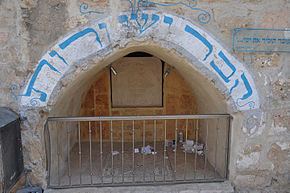 | ||
Visit to the tomb of ruth and jesse in hebron
The tomb of Jesse and Ruth (alt. Tomb of Ruth and Yishai) is an ancient structure located in the Tel Rumeida section of Hebron. Since the Middle Ages it has been claimed to be the burial tomb of the Biblical Jesse, father of King David and that of Ruth, great-grandmother of King David and matriarch of converts to Judaism. In Palestinian tradition it is said to be the Al-Arba'een mosque dating back to the times of Saladin.
Contents
- Visit to the tomb of ruth and jesse in hebron
- Ottoman period
- British mandate period
- Post 1967 period
- References
The structure houses a small synagogue and receives visitors throughout the year, especially on the Jewish holiday of Shavuot, in which the Book of Ruth is read. A medieval stone structure next to it has been excavated and is being used as a synagogue and study hall. Archaeologists postulate it could have been a Crusader fortress.
Ottoman period
The first known written reference to the site housing the tomb of both Jesse and Ruth comes from the 1835 book Love of Jerusalem by Haim Horwitz, referencing local oral traditions.
Menachem Mendel of Kamenitz wrote in 1839,
"Here I write of the graves of the righteous to which I paid my respects. Hebron – Described above is the character and order of behavior of those coming to pray at the Cave of ha-Machpelah. I went there, between the stores, over the grave of Avner ben Ner and was required to pay a Yishmaeli – the grave was in his courtyard – to allow me to enter. Outside of the city I went to the grave of Othniel ben Kenaz and, next to him, are laid to rest 9 students in niches in the wall of a shelter standing in a vineyard. I gave 20 pa’res to the owner of the vineyard. Also in the vineyard was a shelter with 2 graves: one of Jesse, father of David, and one of Ruth, the Moabite. I gave the vineyard owner 20 pa’res. I also went to a grave said to be that of the Righteous Rav, author of “Reshit Hokhma” [Rabbi Eliyahu DeVidas – 16th C Kabbalist and disciple of Rabbi Moshe Cordovero who died in Hebron."
British mandate period
In 1935 Zev Vilnay wrote that visitors were required to pay to access the site and that it once connected to the Tomb of Machpela, but was filled in during the First World War and the entrance was now unknown.
Israeli archaeologist Jacob Pinkerfield (1897–1956) visited the site and wrote about it in his book The Synagogues in Eretz Yisra'el.
Louis-Hugues Vincent (1872 - 1960), a French monk and archaeologist who lived in Jerusalem discusses the site in his two-volume work Hebron in 1923.
Post-1967 period
In the 1970s Prof. Benzion Tavger (1930 - 1983) excavated the site and it was reopened to the public. The site was renovated in 2009.Template:Http://www.israelnationalnews.com/News/News.aspx/131616
